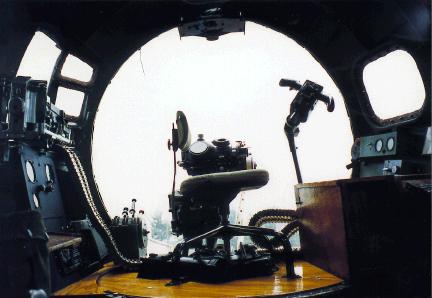THE BEST SEAT IN THE HOUSE?
 | THE BEST SEAT IN THE HOUSE was Don Wise's station, positioned at the very front of the aircraft in order to give the bombardier as clear a view of the approaching target as possible. The position offered a wide, panoramic view of the approaching terrain and landmarks. In wartime, however, it could be a daunting task to sit in the nose of the B-17G aircraft and have a wide-open view of the aerial combat and ground bombardment. Note the "cheek gun" mounted on the left. A similar cheek gun was also mounted on the right of the aircraft, but it is not visible in this photo. The Navigator operated the cheek guns. |
The B-17G Flying Fortress
B-17
Type: Heavy Bomber
Crew: 10: Pilot, Co-Pilot, Navigator,
Bombardier, Flight Engineer, Radio Operator, Ball Turret Gunner, Left
and Right Waist Gunners, and Tail Gunner
Armament: thirteen .50 cal Browning machine guns (G model); Up to 6,000 lbs. of bombs.
Specifications:
Length: 74' 4" (22.66 m)
Height: 19' 1" (5.82 m)
Wingspan: 103' 10" (31.65 m)
Gross Weight: 55000.0 lb
Propulsion:
No. of Engines: 4
Powerplant: Wright R-1820 Cyclone
Horsepower: 1200 hp each
The four Wright R-1820-97 Cyclone radials had General Electric B-22 turbosuperchargers, each rated at 1200 hp for takeoff and 1000 hp at 25,000 feet, with a war emergency power of 1380 hp at 26,700 feet.
Performance:
Range: 1850 miles (2979 km)
Cruise Speed: 170 mph (273 km/h)
Max Speed: 300 mph (483 km/h)
Ceiling: 35000 ft (10667 m)
Maximum speed 263 mph at 25,000 feet, 300 mph at 30,000 feet (war emergency). Cruising speed 150 mph at 25,000 feet. Landing speed 90 mph. Initial climb rate 900 feet per minute. An altitude of 20,000 feet could be attained in 37 minutes. Service ceiling 35,000 feet. Range 1850 miles with 4000 pounds of bombs at 25,000 feet with 2810 gallons of fuel.
A SHORT HISTORY OF THE B-17
The Boeing B-17 "Flying Fortress" was a World War II bomber used primarily against targets in Europe. B-17s from the Eighth Air Force participated in missions, primarily from bases in England. Later, bombers from the 15th Air Force in Italy joined the attack. Because of their long-range capability, formations of B-17s often flew into battle with no fighter escort, relying on the firepower of their combined machine guns for defense.
In 1934, the Boeing Aircraft Company of Seattle, Washington, began construction of a four-engine heavy bomber. Known as Boeing model 299, it first took flight on July 28, 1935. The government ordered production of 13 of these aircraft, now designated the YB-17.
The B-17 received the name "Flying Fortress" from a Seattle reporter who commented on its defensive firepower. The B-17 underwent a number of improvements over its 10-year production span. Models ranged from the YB-17 to the B-17-G model. Throughout the War, the B-17 was refined and improved as battle experience showed the Boeing designers where improvements could be made. The final B-17 production model, the B-17G, was produced in larger quantities (8,680) than any previous model and is considered the definitive "Flying Fortress." With its 13 .50-caliber machine guns -- chin, top, ball and tail turrets; waist and cheek guns -- the B-17G was indeed an airplane that earned the respect of its combatants.
Air crews liked the B-17 for its ability to withstand heavy combat damage and still return its crew safely home. Between 1935 and May of 1945, 12,731 B-17s were produced. Of these aircraft, a staggering 4,735 were lost during combat missions! More B-17s were lost in combat missions than any other kind of aircraft. The gunners of the Flying Fortresses shot down an average of 23 fighters per thousand plane raid. This is compared to an average of 11 shot down by U.S. fighers. The heavy bomber dropped more than 640,000 tons of bombs in Europe, compared with 452,000 tons dropped by B-24s and 436,000 tons dropped by other U.S. aircraft.
The B-17 was not built for leisure, but for the most dangerous of professions--total war. For these reasons, the B-17 bomber was called the "Queen of the Skies".
C O N T E N T S:
Distinguished Flying Cross |
"Pig Chaser" & Its Crew |
The "Best Seat in the House" |
List of 50 Missions |
The Ploesti Campaign |
Medals and Citations |
From the Newspaper |
About Don Wise |
Links to Other Sites |
Return to Home Page |
This Website Designed, Created and Maintained by John K. Wise, Youngest Son of Donald Wise
This site has been restored by Jimmy in memory of John Keith Wise (guestbook)